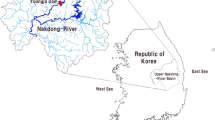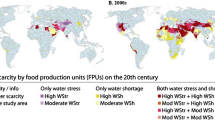Abstract
The paper presents an evaluation of post-project impacts of the Barekese Dam on three riparian communities downstream about 30 years after its construction. A network diagram, which incorporated a mathematical model, was used for impact identification and analysis. The expected environmental impacts, expressed as quantitative weighted impact scores, showed that the dam appeared to have exerted adverse impacts on the environmental quality of the communities. The impacts in the communities, however, increased with relative distances away from the dam and the river suggestive of cumulative impacts transmitted downstream. Strategic measures for improving environmental quality of the communities have been given.
Similar content being viewed by others
References
A. Gilpin, Environmental impact assessment (EIA): cutting edge for the twenty-first century (Cambridge University Press, Cambridge, 1995).
L. Caldwell, Science and the National Environment Policy Act (University of Alabama Press, 1982).
P.J. Culhane, Post-EIS environmental auditing: a first step to making rational environmental assessment a reality, Environ. Prof. 15(1) (1993) 66–75.
L. Ortolano and A. Shepherd, Environmental impact assessment: challenges and opportunities, Impact Assessment. IAIA 13(1) (1995) 8, Spring.
WCD, World Commission on Dams Report, available at http://www.dams.org (2000).
E.P.A. Ghana, Environmental Protection Agency Act (Government of Ghana, 1994).
J.K. Rau and D.C. Wooten (eds.), Environmental Impact Analysis Handbook (McGraw-Hill Book Company, New York, 1980) pp. 8-6–8-24.
B. Julien, Current and future directions for structured impact assessments, Impact Assessment, IAIA 13(4) (1995) 403–432.
GISD, Ghana Information Services Department, GHANA – A Brief Guide (1994).
K. Boafo-Arthur, The political economy of Ghana's foreign policy. Past, present and the future, Ghana Soc. Sci. J. 1(1) (2000) 1–30, January.
L.W. Canter, Environmental Impact Assessment, 2nd edn. (McGraw-Hill, Inc., New York, 1996) pp. 550–552.
I.K. Tetteh, An assessment of the health and socio-economic impacts of the Barekese Dam on human communities downstream. M.Sc. Thesis, Department of Biological Sciences, KNUST, Kumasi, Ghana (1999) p.194.
I.K. Tetteh, E. Frempong and E., Awuah, An analysis of the environmental health impact of the Barekese Dam in Kumasi, Ghana J. Environ. Manag. 72 (2004) 189–194.
American Public Health Association/American Water Works Association/Water Environment Federation (1995), Standard Methods for the Examination of Water and Wastewater (18th edn.), eds. A.D Eaton, L.S. Clesceri and A.E. Greenberg (Washington, DC 20005, 1995) pp. 10–157.
Ghana EPA, General Effluents Quality Guidelines for Discharges into Natural Bodies of Water (1999).
B.D. Clark, K. Chapman, R. Bisset and P. Wathern, Methods of environmental impact analysis, Built Environ. 4(2) (1978) 111–121.
J. Shopley and R. Fuggle, A comprehensive review of current environmental Impact assessment methods and techniques, J. Environ. Manag. 18 (1984) 25–47.
I.K. Tetteh, E. Awuah and E. Frempong, Development of a weighting system for use in Environmental Health Impact Assessment associated with water impoundment projects in Ghana and its application 1, Journal of the Ghana Science Association 6(2) (2004) 59–69.
D.H. Sanders, Statistics – A Fresh Approach 4th edn. (McGraw Hill Publishing Company, New York, 1990) pp. 253–288.
D. Freedman, R. Pisani and R. Purves, Statistics (W. W. Norton and Company, New York, 1978) pp. 203–230.
C. Harinasuta, S. Sornmani, T. Bunnag and P. Vivatanasesth, Investigation on socio-economic status, health and nutritional problems in connection with water resource development in south-east Asia. Tropical Medicine and Public Health Projects. TROPMED/pp-08 SEAMEO (1978) p.240.
L. Changming and Z. Dakang, Environmental issues of the Three-Gorges project: an overview. In: UNESCO/UNEP. The Impact of Large Water Projects on the Environment. Proceedings of an International Symposium, UNESCO, UNEP, IIASA and IAHS, 21–31 October (1990) pp. 249–260.
US-CEQ, United States Council on Environmental Quality. Regulations Implementing the National Environmental Policy Act. 40 CFR 1508.7, 1508.8, 1508.25 (1978).
A.M. Lilienfeld and D.E. Lilienfeld, Foundations of Epidemiology 2nd edn. (Oxford University Press, Oxford, 1980) pp. 61–62.
Daily Graphic, Rural people to pay for water supply, Ghana Newspaper. Tuesday, 21 October (1997) pp. 12–13.
B. Moss, Ecology of Freshwater, 2nd edn. (Blackwell Scientific Publications, Oxford, 1988) pp. 258–272.
R.C.S. Walters, Dam Geology, 2nd edn. (Wiley, Texas, 1971) pp. 50–62.
N.K. Sarma, Environmental impacts of water resources projects: the Indian experience, in UNESCO/UNEP. Impacts of Large Water Projects on the Environment. UNEP, EMINWA, UNESCO. Proceedings of an International Symposium, UNESCO, UNEP, IIASA and IAHS 21–31 October (1990) pp. 239–248.
I.K. Tetteh and K. Okyere-Kumah, Waste recycling: the potential of coconut shell wastes, Technocrat 2(3) (2004) 6–7.
F.M.A. Ukoli, Introduction to Parasitology in Tropical Africa (Wiley, Great Britain, 1984) pp. 1–16, 52–89, 399–432.
K. Tones and S. Tilford, Health Education – Effectiveness, Efficiency and Equity, 2nd edn. (Chapman and Hall, London, 1994) p. 462.
W.H. Greene and B.G. Simons-Morton, Introduction to Health Education (Waveland Press, Inc., Illinois, 1984) p. 462.
World Health Organisation, Environmental management for vector control. Fourth report of the WHO Expert Committee on Vector Biology and Control”, WHO Technical Report Series no. 649 (WHO, Geneva, 1980).
World Health Organisation, Manual on environmental management for mosquito control, WHO Offset Publication no. 66 (WHO, Geneva, 1982).
Author information
Authors and Affiliations
Corresponding author
Rights and permissions
About this article
Cite this article
Tetteh, I.K., Awuah, E. & Frempong, E. Post-project analysis: The use of a network diagram for environmental evaluation of the Barekese Dam, Kumasi, Ghana. Environ Model Assess 11, 235–242 (2006). https://doi.org/10.1007/s10666-005-9021-7
Received:
Accepted:
Published:
Issue Date:
DOI: https://doi.org/10.1007/s10666-005-9021-7




